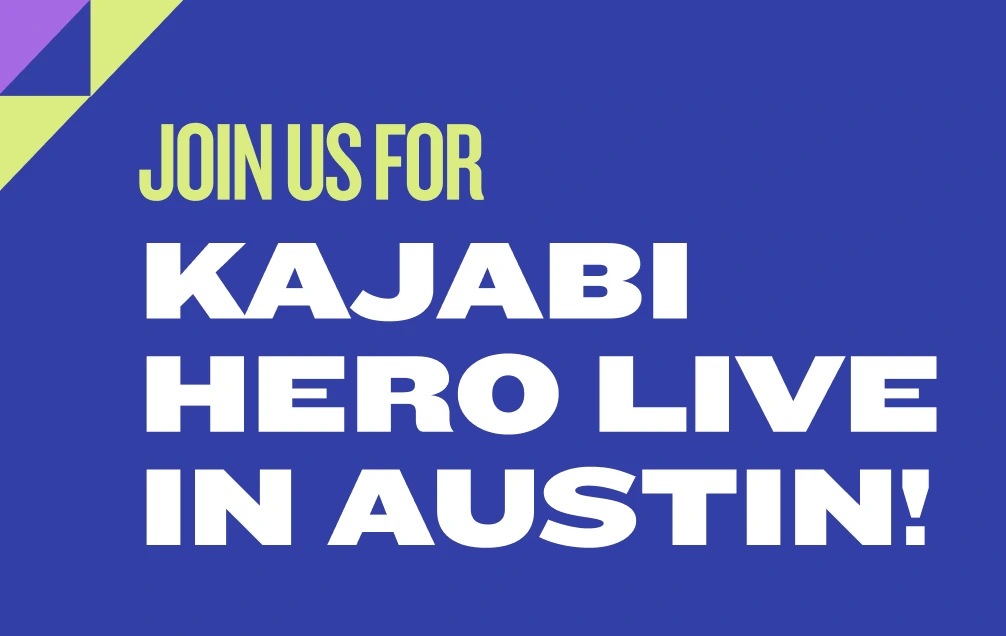Get free expert insights and tips to grow your knowledge business sent right to your inbox.
If you’re interested in selling an online course, you’ve likely come across both Kajabi and Skillshare as possible platforms for marketing and selling your knowledge. Which is right for you? This detailed Kajabi vs. Skillshare will help you decide.
Each of these platforms has a unique approach to selling courses online, so a feature-by-feature comparison of Skillshare and Kajabi is nearly impossible. Their features are too diverse to make a detailed apples-to-apples comparison meaningful or helpful.
So instead, we’re going to break down the core differences between the platforms, a few caveats you should know about Skillshare, and how each platform works to help you sell courses online.
By the end of this review, you’ll be able to better understand what each service has to offer, the costs involved, and how to get started so you can start selling with confidence. Let’s jump right in!
Skillshare vs. Kajabi: the core differences
At its core, Skillshare is a teaching community where users can learn almost anything, from arts and crafts to languages, lifestyle skills, and more. On Skillshare, you’re just as likely to find courses on how to paint with thread as you are to find courses on creativity or business.
Courses on Skillshare generally center around animation, design, photography, film, creativity, and similar personal development topics. But you’ll also find courses on technical topics, such as mobile development, data science, and web-related technologies.
Skillshare’s website is aimed at its students. It offers them self-guided training designed to inspire while fitting into their daily routine.
As an instructor, you’ll publish a class. Skillshare will promote it. And you’ll earn royalties. But your class becomes part of Skillshare’s marketplace. It’s not designed to help you build a business. Instead, you help Skillshare grow by adding to their collection of courses.
Anyone can apply to become a teacher on Skillshare, and many teachers profiled on the site are award-winning experts in their respective fields. However, as we’ll get into below, there are some important points you’ll want to consider before you dive in. Most importantly: how much you can earn and what you can teach about.
Kajabi isn’t a learning marketplace. Nor does it market to the student. It goes well beyond a teaching community. It’s a business-building suite designed to help digital entrepreneurs launch and grow a profitable business.
Using Kajabi, you can sell an online course or membership, as well as other digital products. It gives you a complete tool set for growing your business, including:
- Blogs
- Podcasts
- Landing pages
- Email marketing
- Sales pipelines
- Marketing automation
This allows you to not only share your knowledge, but also market yourself as an expert and position yourself as a credible authority in your chosen niche. Rather than just “sell a course,” you’re building a knowledge business, which means you can spin off multiple other product ideas and sell them through the same comprehensive platform. For example:
- Paid newsletters
- Advanced course upsells
- Paid member communities
- Video walkthroughs
- And much more
Kajabi gives you the flexibility to create and promote all of these options for your digital product, helping to grow and diversify your revenue sources.
Skillshare vs. Kajabi pricing
Before we get into how much you can earn on Skillshare, it’s important to cover how Skillshare handles pricing on the user end. You can create an account for free on Skillshare, which gives you a small selection of videos and learning materials, like PDFs and access to community discussions.
Skillshare offers a small selection of free courses. Users may also purchase a premium membership at $8 per month, or a Teams option for two or more people, starting at $159 per user, per year.
These paid options unlock all courses on Skillshare, including user- and celebrity-created courses. A premium account also removes ads and lets you use the Skillshare mobile app to access classes on the go.
The team option is essentially the same thing but at a much higher cost. It’s designed for businesses to offer Skillshare courses to their employees.
It doesn’t cost you anything to become a teacher on Skillshare. However, your earnings are also restricted (more on that below).
Conversely, Kajabi offers three tiered plans for creators which, if paid annually (listed below), offer a slight discount.
- Basic - $119/month
- Growth - $159/month
- Pro - $319/month
Unlike many other online learning platforms, Kajabi doesn’t charge more to unlock additional features. Instead, all features are unlocked for all three packages. The Growth and Pro account simply allow you to scale your business, offering more active subscribers and more email contacts for your mailing list.
Essentially, Kajabi allows you to uplevel your membership as your business grows. You’re never asked to upgrade to access a tool. And you’re never penalized for your success.
As your business grows and scales, you can freely upgrade your Kajabi package at any time. This allows you to add more paid subscribers, more email contacts for your list, and sell more products, while keeping the same features you already love.
This is important, as it also ties in neatly with how much you can earn. And since this is by far the most common question when doing a Skillshare vs. Kajabi comparison, we’ll dive into that next.
How much can you make on Skillshare?
Skillshare teachers earn money through royalties and referrals. Every month, 30% of all of Skillshare’s total revenues from memberships go into a pool that teachers are paid from. The amount you are paid depends on the share of the paid minutes watched by students (both those in free trials and those with premium memberships) each month.
Skillshare’s own website gives the following example:
“If a teacher’s classes receive 5% of the minutes watched by members, the teacher receives 5% of the royalty pool. Because we are a subscription service, the size of the royalty pool and the number of minutes watched on Skillshare fluctuates from month to month.”
It continues: “On average, teachers can earn $200/month on Skillshare, with repeat, long-term teachers earning upwards of $3,000.”
In order to receive any payment at all for a month, you must have a minimum total of 30 paid minutes watched across all of your classes within that month.
You also get a $10 flat fee for every student you refer to Skillshare that signs up for a membership.
Let’s break down what that actually means for you, the content provider.
In short, you’re not only limited in how much you can earn by how much your students interact with your course, but you’re also further limited by how much (or how little) income Skillshare itself generates in a given month.
And although many of the courses on Skillshare are high quality, it doesn’t matter at the end of the day whether you poured hours of knowledge and training and detail into your videos versus someone who just slapped something together at the last minute: You both get paid from the same pool.
Thankfully, Skillshare does have some quality guidelines in place to keep its courses above a certain threshold. But there’s no set style, outline, or design for classes uploaded to Skillshare.
The question you have to ask yourself is, when it comes to selling a course online, do you really want to be limited by factors beyond your control that determine how much you can earn?
Kajabi doesn’t think so, which is why there are no restrictions or limits on how much you can earn.
Want to sell an online course for $99 with a $199/month upsell to a premium newsletter for subscribers only? Go for it. Want to create a paid community membership with a price tag of $399/year? You have our full support.
And no matter how you choose to structure your course or membership pricing, all you’ll pay is the monthly (or yearly) fee for the Kajabi pricing tier you’ve chosen. That means more of your money stays in your pocket, where it belongs.
One of the key differences between Skillshare and Kajabi is that Skillshare is designed to give you a channel to sell an online course in a community-like setting. Kajabi is designed to give you multiple channels through which you can sell an online course as part of your thriving business.
Your course doesn’t have to be the be-all and end-all of your foray into entrepreneurship. It can be the start of a digital business. You can decide who your audience is, how you want to engage with them, and what types of digital products you want to offer.
Your courses on Kajabi position you as the expert. They help you build meaningful, lasting relationships with students and members who want to learn what you have to share. While Kajabi is there to facilitate you, they don’t mandate how to run your business.
Skillshare class guidelines
Fortunately, despite their restrictive payment model, Skillshare does have a set of guidelines designed to help aspiring teachers create high-quality courses. Here are a few of the guidelines you’ll receive as an instructor:
Classes must be taught on a permitted topic - There’s a lot of flexibility in terms of class topics. Skillshare concentrates on creative arts and some technical topics, but there are also a lot of course topics that aren’t permitted (and you’ll be surprised to learn what they are). We’ll delve into this in a minute, since it’s important to know what you can and cannot talk about before you begin creating your course.
Instructional videos must meet certain audio/video standards - That means no distracting backgrounds, no buzzing, humming, or other audio background noises. Audio must match your footage, and video must be shot in high resolution (720p or HD) quality. Any screenshots or screencasts must not be blurry or pixelated.
This rule is entirely understandable, since we learn best from high-quality materials. It’s a good idea to understand basic audio and video requirements, so you can create the best possible materials for your courses.
You must have an introduction video - This is the very first video lesson of your course, and it’s designed to let your students know what they can expect. It also provides you with an opportunity to share a bit about your experience and background so that your students can get to know you. You can use this introduction video as a trailer for your class, but keep in mind that it doesn't count toward the minutes watched for your total payment.
Introduction videos overall aren’t a bad thing to have, but if your students are already familiar with who you are (from your blog or podcast, for example), then it may not be necessary. On Skillshare, however, it’s required.
Include a class project - If this takes you back to your primary school days, there’s unfortunately no getting out of it. Class projects of some form or another are another requirement from Skillshare. What your students do or make is entirely up to you, but this component must be included.
Limited self-promotion - The focus should be on the course material, not promoting other courses or materials you have to offer.
Other requirements for your Skillshare course include more common-sense arrangements, such as incorporating visual material, making your class length at least 10 minutes, organizing your content well, and adhering to community guidelines.
All Skillshare courses are moderated by a team that examines your course and approves it before you can sell it online.
Kajabi has no concrete course requirements. Your course can be any length and there are no requirements for specific class projects, presentations, or other stringent points to follow.
Of course, it’s recommended that your course materials be of the highest possible quality. To that end, Kajabi University, our online educational portal, teaches you how to create a high-quality course.
Kajabi University is included with your Kajabi membership and centers around not just building a course, but also marketing your course and turning your course and membership into an actual business. You don’t have to have any business savvy before joining Kajabi. All you need is deep knowledge about a particular topic and the willingness to share it. The platform guides you through the rest.
Not only does Kajabi University give you concrete ideas on how to build your course, but it also guides you through the process step by step, including building your website, setting up your email list, creating your first marketing pipeline to follow up with new and prospective customers and much more. In short, everything you need to own your own brand.
Restrictive topics on Skillshare
It’s important to understand what is and isn’t allowed on Skillshare. There are ten different items that fall under “Restricted Topics.” This means that no matter how experienced or knowledgeable you are on these topics, you’re not allowed to create courses about them on Skillshare. They include:
- Any kind of passive income business strategy (so no creating courses on how to create courses that make money for you every month)
- How to amass a large number of followers, students, members, or any other group
- Anything to do with dating, romance, or relationships
- Any kind of class that teaches how to use other educational platforms (you can’t create a Skillshare course on how to use Kajabi, for example)
- Any course that shows students how to resell existing products or services (drop-shipping, multi-level marketing, etc.)
- Any classes about mathematics, physical/life sciences, engineering, or standardized testing
- Classes that repeatedly reference religion, spirituality, or politics
- Any classes about fitness or exercise
- Classes about pet care
- Classes that focus on beauty regimens or cosmetology (so if you want to show off that gorgeous makeup palette, too bad)
Although it seems like a short list, these prohibited course topics actually cover a broad swath of material. Want to teach new moms how to get rid of stubborn pregnancy belly fat through a combination of diet and exercise? You’re out of luck with Skillshare. Want to help fellow engineering students prepare for a big test by letting them know the types of content they should focus on? Too bad.
Kajabi does have some acceptable use terms for content being sold through Kajabi, such as prohibiting violence and hate speech, but we do not restrict any of the topics listed above. If you’ve built up a successful business using dropshipping and want to teach others how to do the same, you’re welcome to! If you want to show off how to highlight your natural beauty using organic, cruelty-free cosmetics, welcome aboard!
With Kajabi, you’re in complete control at all times. You aren’t restricted in sharing your knowledge just because it happens to pertain to a topic that the platform views as off-limits.
Is Skillshare worth it for teachers?
Good question. The answer depends on what you’re trying to achieve as a teacher.
If course creation is a hobby for you, and if you’re okay with the restrictions that Skillshare places on you, then yes, it might be worth it. But if you want to be fairly compensated for your work, and if you want to leverage your course to build a profitable business, then Kajabi is your best option.
Here’s what you need to remember:
Skillshare is a marketplace. It requires no up-front financial investment. And it could help you establish yourself as an expert at what you do. But by choosing Skillshare, you have to follow their rules and are subject to their revenue share model.
With Kajabi, you’re in full control. It takes more work, sure, but you can also generate more revenue. And there’s no limit to what you can accomplish as you grow your business.
The bottom line on Kajabi vs. Skillshare
As you can see, Skillshare vs. Kajabi is very much an apples-to-oranges comparison. Skillshare can be a great platform if you want to sell a one-off course that doesn't fall into one of its restricted categories.
It could be a good place to start if you can create a course that ticks all their requirements. But keep in mind, no matter how much effort you pour into your course creation, how much (or how little) you’re paid is determined by factors that are largely beyond your control.
While a great course should understandably get more attention and more eyeballs, that isn’t always the case.
At Kajabi, we don’t think you should be penalized for it. In fact, we believe that everyone has knowledge worth sharing — whether it’s about how to train your german shepherd or to trade cryptocurrency.
And Kajabi gives you all the tools you need to tell the world about what you know. From email and podcasts to marketing pipelines and automations that are done for you, Kajabi focuses on helping you turn your passion or hobby into a business.
You may not think that the two things can (or should) mix, but we assure you they can. Many professionals and experts use Kajabi to create a lucrative second income, and many more have left their jobs to pursue their hobby full-time using Kajabi as their instructional platform.
The best part is, you’re not in it alone. Using Kajabi’s thriving user community, dedicated knowledge base, and Kajabi University, you’ll learn everything you need to know, not just about building a course, but about turning that course into the cornerstone of your business.
There are no limits to how much you can earn and you won’t find your profits being eaten away by per-transaction fees or commissions. Simply put, you’re free to create, and we give you all the tools, guidance, and support you need to do so, right from the very start.
At Kajabi, we serve you, so you can serve your community. That’s the Kajabi difference.
We invite you to try Kajabi risk-free with a 14-day trial. Explore all of the features, including our intuitive website builder, customizable templates, smart email marketing, easy marketing pipelines and other automations. Reach out to our friendly, helpful community and connect with your fellow Kajabi Heroes to discover all the tools and guidance you need to teach what you love and earn from it. Start today risk-free!
Check out other Kajabi comparisons:
Kajabi vs. LearnWorlds
Kajabi vs. Mailchimp
Kajabi vs. Squarespace
Kajabi vs. Ontraport
Kajabi vs. ConvertKit
Kajabi vs. Gumroad
Kajabi vs. Samcart
Kajabi vs. Systeme
Kajabi vs. Clixli
Kajabi vs. CoachAccountable
Kajabi vs. Teachable
Kajabi vs. Thinkific
Kajabi vs. Podia
Kajabi vs. Patreon
Kajabi vs. Wordpress
Kajabi vs. Clickfunnels
Kajabi vs. Udemy














